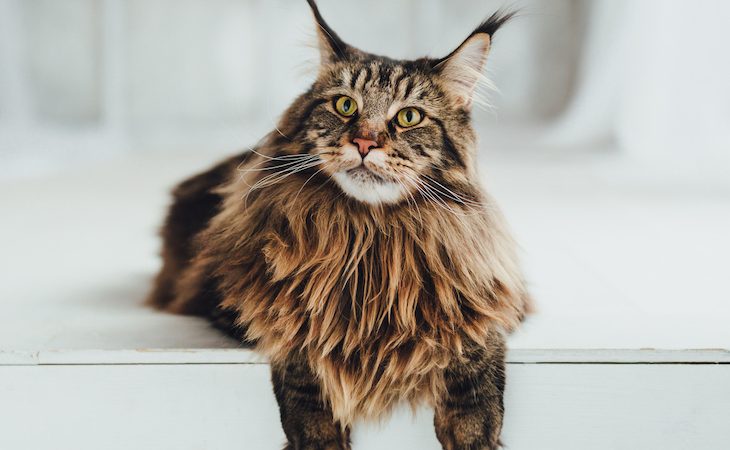The Maine Coon is today one of the world’s most admired and popular cat breeds. This magnificent ‘gentle giant’ is universally loved thanks to its large size, fluffy coat and affectionate nature. While calm, Maine Coons also love playtime. And despite their imposing size, they can adapt well to apartment living (although safe to say, family life will give them the greatest joy).
Despite the breed’s popularity, here are 20 things you probably didn’t know about the Maine Coon!
#1. Maine Coons love water!
It is usually said that cats don’t like water, but this isn’t the case for this water-loving breed! Other cat breeds such as the Norwegian Forest Cat and Turkish Angora are also known to be fond of the water. Interesting then that the Maine Coon has been linked to both as a possible descendent.
In fact, a number of Maine Coon owners agree that their cats are somewhat obsessed with water. Given the Maine Coon’s well-known intelligence, there have been some rather unusual and intriguing situations involving water. It’s not uncommon to hear of one opening the tap to drink, wading in the toilet bowl, asleep in the middle of the kitchen or bathroom sink, out in the pool for a summertime swim, intentionally spilling glasses of water to play with or splash about, or even inviting themselves into your shower for a ‘couple’s wash’!
A Maine Coon’s comfort around water can be advantageous for one very good reason – for bathtime. Since the Maine Coon sports a long coat, dirt and knots can very easily become matted within the fur. Regular grooming, including occasional bathing, is therefore essential. It is nevertheless advisable to get your cat used to water from a very young age. After all, not ALL cats love water no matter the breed!
#2. They are the oldest native North American breed
Maine Coons were recognized as the first purebred cat in the US, a native to the state of Maine. This recognition was attributed to their longstanding presence within the region and their adaptability to their conditions. While no one categorically knows the true origins of the Maine Coon, various theories and legends abound. What is widely believed is that the Maine Coon developed from a cross between long-haired cats of either European and/or ancient Egyptian descent together with local wild breeds.
#3. Maine Coons are late bloomers
Despite its impressive size, Maine Coons mature into adults much later than the average domestic cat breed. Adult maturity for Maine Coons is usually reached by about three years, however some won’t reach full size until about 4-5 years. In contrast, most cat breeds reach maturity at the age of about one. Why is this exactly?
The reasons are breed specific and vary, but their long length appears to play a part in their slower-than-average development as the body adjusts to supporting the skeletal and muscular framework. In fact, breed standards stipulate the importance of a purebred Maine Coon’s length. Females are typically smaller in size but still take a similar time to fully mature.
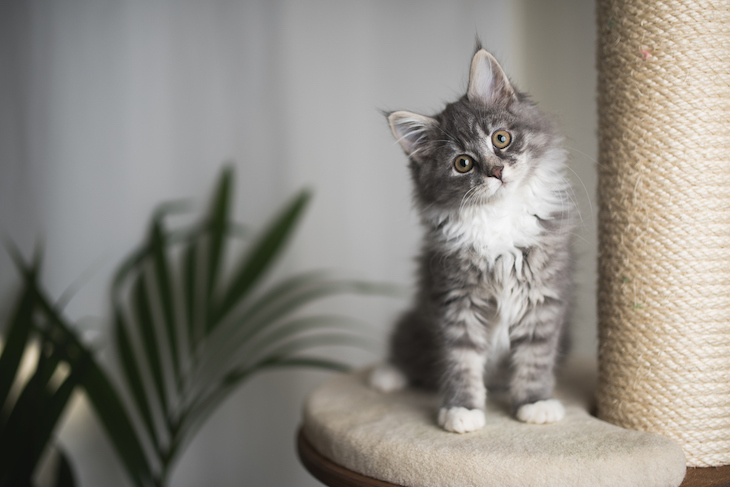
#4. Legend links its name to a US state and a racoon
The origins of the Maine Coon are to this day still debated. Many tales of folklore and mystery are still thrown about during discussions of the breed.
Legend has it that the Maine Coon was the result of breeding a raccoon with a wild cat of Maine. Whilst this might explain its luscious, thick fur, as well as its name, science may not see it in quite the same way. In fact, it is physically impossible for the two different species to breed. So while there might be some similarities, we can safely put that legend to bed!
#5. A Maine Coon holds the record for the world’s longest cat
The Maine Coon is one of the world’s largest cat breeds. So it’s no surprise that the world’s longest domestic cat, awarded by the Guinness World Records, is also a Maine Coon.
Up until May 2018, Ludo the Maine Coon held the coveted title. He measured a staggering 118.33cm (3ft 10.59in). Meanwhile, in Melbourne, Australia, what was thought to be a standard kitten had grown into an enormous Maine Coon and was attracting international attention. Omar was preparing to steal the title from Ludo after his parents registered him with the Guinness World Records. According to his parents, Omar measured in at 120cm (47in) and ate a diet of raw kangaroo meat. However, he was pipped at the post and the title went to Italian-based Maine Coon, Barivel. Barivel today measures 120cm (3ft 11.2in) long and is the current world record holder for the longest cat. Interestingly, Barivel is shy and quiet!
You can follow Omar and Barivel’s journeys on their Instagram accounts where they are followed by more than 142k and 2,500 subscribers respectively.
#6. Harry Potter featured a Maine Coon (or four!)
Do you remember Mrs Norris, Hogwarts janitor Argus Filch’s cat in Harry Potter? Well, Mrs Norris was indeed a Maine Coon!
The cunning, sneaky cat was her owner’s right-hand (wo)man. She prowled the halls of the wizard school, carefully watching the students to warn Filch of any misbehavior. It took an incredible four Maine Coon cats to carry out her demanding role in the film series!
#7. Maine Coons are said to be descended from Queen Marie Antoinette’s Angora cats
Another legend concerning the origin of the Maine Coon suggests that French Queen Marie Antoinette was behind the origins of the Maine Coon. According to reports, the Queen was due to flee the French revolution by sailing to Maine, USA on the ship Sally, captained by Samuel Clough. Mr Clough travelled regularly between Europe and the United States and was known for his ability to transport stowaways during his voyages. It was said that Marie Antoinette’s luggage was entrusted to him, among which were six Angoran cats. Unfortunately, the Queen was sentenced to death before she could set sail, however her luggage and cats apparently made it to Maine. It is here that the breed is said to have evolved when the cats bred with local felines resulting in the medium-long hair cat that later became known as the Maine Coon.
#8. Maine Coons can be trained
Maine Coons are an intelligent breed of cat and often referred to as a being dog-like. They are affectionate and playful, sometimes even clingy, and they can also learn tricks. This makes them a highly suitable cat breed for families seeking a cat but with a little something extra for the kids. They are also very sociable and will likely get along well with other pets, especially dogs. So why not train them all together!
If you’re looking to train your Maine Coon kitten, the ideal age is around five months old. The recommended approach is to tackle two tasks for a period of time, and once these new skills are acquired, others can be added into the mix. Like with dogs, using positive reinforcement training methods are the ideal way to help train your cat.
It’s not uncommon to find a Maine Coon playing fetch similar to the way you might with a dog. Perhaps not as energetic, this can still be a great way to spend time together and ensure they are being stimulated regularly, particularly if they are typically kept indoors. With the right introduction, they can also adapt well to a leash and a daily walk might well be expected!
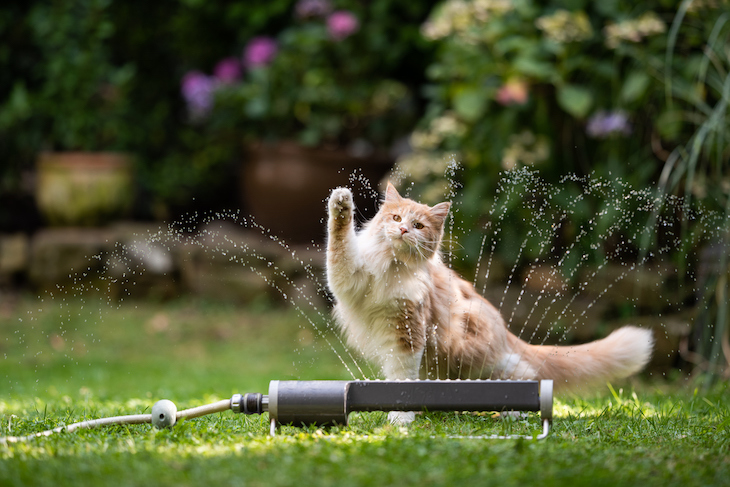
#9. Breed standards permit multiple coat colors and markings
The Cat Fanciers’ Association was the first organization to formally recognize the Maine Coon breed. However, there are a number of similar organizations around the world that have their own breed specifications. Overall, breed standards are relatively similar and ensure the continuation of the breed in its purest form, without cross-breeding. Within these standards lies the coat and its color variations.
In terms of length, a true Maine Coon coat is medium-long, shaggy but soft, and of uneven length. It is characterized by longer guard hairs on the outer with a silky satin undercoat. The hair is shorter on the shoulders and longer on the stomach and britches.
Standard categories of coat color include: single-colored, tabby, silver/smoke, and parti-colored. Within these categories, multiple variations are permitted. Single coat colors include white, black, blue, red, and cream. Tabby patterns include the classic (most common Maine Coon coat), mackerel (or tiger), and ticked varieties. Silver (shaded) and smoke variations include the silver tabby and smoke tabby, while parti-color variations incorporate bi- and tri-color coats, followed by other rarer coat colors including Harlequin and Van.
#10. Maine Coons are well-adapted to harsh winter conditions
The state of Maine, USA offers up some harsh winter conditions for both animals and humans alike. Cold and snowy conditions prevail in the winter where the temperature has been reported to drop to -50F (-45.5C). In a normal year, the winter average sits at about 12°F (-11.1°C), which is still very cold all things considered. But thanks to its incredible adaptability, the Maine Coon is well designed for such conditions.
The fur on the Maine Coon is composed of several layers, allowing the animal to be protected from the cold. Adapted physical characteristics also allow the breed to navigate their winter environments. For example, their large legs are well adapted to walking on snow, while its bushy tail can be wrapped around its body to help retain and generate heat.
#11. A Maine Coon has already been cloned!
In 2004, a Maine Coon called Little Nicky was born and became the first commercially produced pet. Little Nicky was a carbon copy of Nicky, a beloved Maine Coon belonging to Texas woman Julie. Following Nicky’s death, Julie called on San Francisco company Genetic Savings and Clone to help recreate her beloved cat. Tissue biopsies were taken from Nicky then grown in a petri dish before being preserved, ready for use. The DNA was then implanted into surrogate eggs, and then a surrogate female cat, and Little Nicky was subsequently born. The cloning process cost an impressive US$50,000 and Little Nicky became the spitting image of her predecessor. The only difference? The price tag!
#12. Maine Coons can have 6 toes
At the time the Maine Coon was gaining popularity and began to hit breeder’s radars, some newborn kittens were presenting with six toes. These six-toed cats, called polydactyls, were a result of a genetic mutation during the breeding process. Some experts believed the sixth toe was of fundamental use to the cat as an extra aid when walking in the snow. Following the breed’s official recognition by the Cat Fanciers’ Association in 1976, these polydactyls were systematically disqualified and were gradually removed as registered breeding cats. These days, 6-toed Maine Coons are harder to come by although still do exist.
#13. Here’s looking at an expressive cat!
All cats express themselves using body language. But they also do this with several types of sounds. Among them, purring, meowing, whistling, wailing, growling, chirping, trilling and cooing are the most recognized sounds. For Maine Coons, trilling is very often used. This sound, which resembles a cooing sound, is somewhere between a purr and a meow. It usually lasts less than a second and is more of an ascending tone. This sound is taught by a mother cat to her kittens to greet the others in the litter, as well as to other cats or people in the household.
As a regular triller, chirper, and cooer, Maine Coons are commonly referred to as big talkers! Interestingly, meowing is much less frequent when compared to other cats. According to studies, this big-eared cat breed uses more than 63 different sounds to express itself! Take the time to study some of these different sounds as it will allow you to better understand your cat in a way that may help you to create a more harmonious relationship with them.
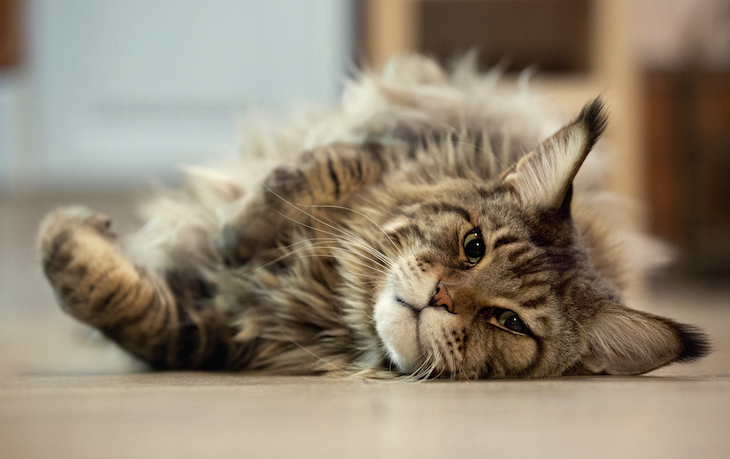
#14. And here’s looking at an expensive cat!
Maine Coons are said to be one of the 10 most expensive cats in the world. The most expensive breed is the Ashera – a rare and exotic domestic breed that looks more like it belongs on the desert plains of Africa or Asia. In fact, the Ashera is almost exactly that, being a cross between a wild African Serval, an Asian Leopard cat and a standard domestic breed. Purchasing an Ashera will set you back anywhere from US$22,000, up to US$125,000. Not exactly pocket money prices!
That said, neither is the Maine Coon an affordable breed to all. While not remotely close in cost to the Ashera, a Maine Coon can still set you back anywhere between US$400 and US$1500, and even up to US$2500 depending on the breed standard and/or reputation of the breeder. The price is also likely to vary depending on the sex and any desirable physical characteristics.
For example, a female Maine Coon kitten is likely to cost anywhere between $300 and $1000 less than its male counterpart. Price differences typically stem from breed standards set by organizations like the Cat Fanciers’ Association and other similar bodies. These standards take into consideration size, color and other physical traits and deem one Maine Coon more desirable and expensive than another based on such characteristics. Indeed, some colors are rarer than others, while some “defects” can exclude a Maine Coon from fitting the breed standard requirements for competitive entry, thus rendering them less expensive.
Depending on the report you read, the Maine Coon usually comes in between 7th and 10th place for the most expensive cat. The Savannah is the 2nd most expensive breed, typically available for an impressive US$20,000. Other expensive breeds to round out a typical top 10 list include the Bengal, Scottish Fold, Peterbald, Sphynx, Siberian Forest, American Curl, and Ragdoll. Of course, there are plenty more to add to this list!
#15. Maine Coons don’t like heights!
Contrary to what we generally think of when it comes to cats and height, Maine Coons fall into the category of preferring lower altitudes. Why this is is not entirely understood, however some suggest their large size may make them less nimble up high. As a traditional snow-dwelling creature, perhaps they are more at ease navigating the powder under their feet rather than the branches above.
Either way, you may still need to lend a rescuing hand if your Maine Coon gets a little stuck up high!
#16. Maine Coons are great with children
Appropriately named, the ‘gentle giant’ Maine Coon has a very sweet, kind and patient temperament making them ideal playmates for children. In fact, the presence of a cat allows children to acquire responsibilities as well as develop their sociability. Maine Coons can be a great addition to any household looking to give their child/ren this valuable form of interaction.
Some studies have also shown the positive interactions between children with autism and the Maine Coon breed. The gentle, calming presence of the water-loving Maine Coon has even been known to ease fears of water in children struggling with the fear. It is, however, important to remember that various rules still need to be established in the presence of a pet. Tail pulling and hitting are absolute no-nos and will need to be carefully managed by any parent or guardian.
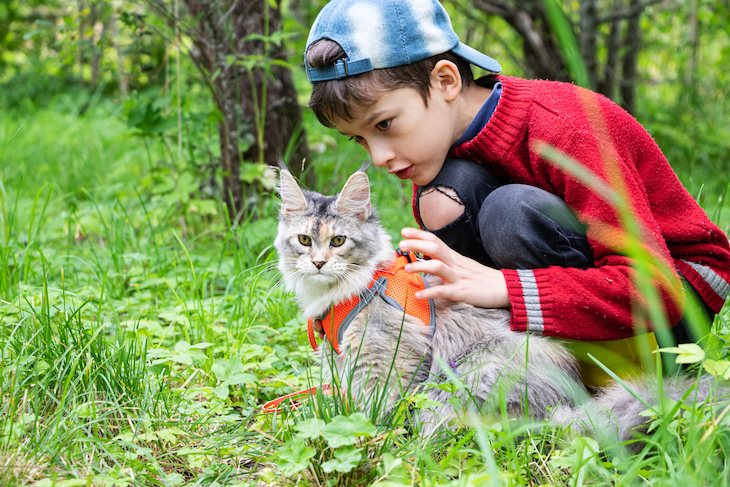
#17. One of the most popular breeds worldwide
In surveys from around the world, Maine Coons often round out the top five most popular cat breeds. In fact, it is one of the most popular cat breeds in the US, France, Japan and throughout Europea. Why? Simply put, this magnificent, large breed makes for a great companion and is often referred to as the dog of the cat world – a friendly, ‘gentle giant’ playmate!
It goes without saying that it’s always important to choose a cat to suit your lifestyle. But we understand why many choose to head directly to the Maine Coon breed.
As America’s oldest native breed, it’s no surprise why there is so much love for this animal in the land of the free. In 2015, the Cat Fanciers’ Association registered the Maine Coon as the 3rd most popular breed that year. Results have been similar throughout parts of Europe, where the breed is said to be potentially descended. In France, Maine Coon adoptions have topped the list each year for the past eight! While the Maine Coon is designed for winter conditions, warmer climates still appreciate the beauty of this majestic feline.
#18. Maine Coons require plenty of grooming
As previously mentioned, Maine Coons sport a medium-long coat. This gives the breed an undeniably plush and majestic look. However, it also comes with a little work. Grooming will most definitely be required!
Regardless of the quality of a Maine Coon’s coat, it will still need to be brushed at least three times a week. This will need to be done with a suitable brush that is designed for the type of coat. This is to help ensure it is kept strong, shiny and free from knots.
Ideally, you should get your cat used to brushing from an early age. This can be a simple 5-minute brush each day. This way, you’ll help them to adjust to the grooming process and alleviate any knots or clumping, particularly around the stomach area where long-haired cats are more prone to matting. Choosing a high-quality diet suitable for your Maine Coon, including supplements based on malt and rich in omega-3, can also help to strengthen the coat and produce fewer hairballs.
#19. Maine Coons are very playful
Having read through the above, you’ll now know that Maine Coons love to play!
While kittens are known to be very playful and curious as they discover their world around them, this character trait tends to gradually disappear when the cat reaches maturity (or adulthood). This playfulness tends to make way for a calmer, more independent, and sometimes even shy temperament.
Enter the Maine Coon to flip this normality on its head! Instead, this lusciously large cat typically retains its playful nature until it no longer has the physical ability to play. This makes the Maine Coon an ideal companion for families with children or those wanting a dog without the same demands of a dog. Even playing games such a fetch may be on your Maine Coon’s radar, as will snuggling in for regular cuddles. Granted, there are always those who buck the trend and remain, well, typically cat-like. However, when it comes to the Maine Coon, it’s fairly safe to say you’ll have a playmate in them for life!
#20. A popular breed used in pet therapy
Over the years, pet therapy has been increasingly used to help treat and rehabilitate those with or having suffered from various medical conditions. These can range from cancers to conditions such as autism and ADHD to rehabilitation following an accident or intense treatment.
It’s well-documented that animals can be very attune to human emotion and conditions, and this can also be said for the Maine Coon. Of course, not every Maine Coon will be ideal to use in such circumstances. However, their high levels of intelligence, emotional awareness, empathy and patience all make for a great candidate to be used in pet therapy (otherwise known as zoo therapy).
Following strict guidelines, some hospitals allow the presence of a Maine Coon to aid in the patient recovery process. Maine Coons have also helped with cases of autism in certain circumstances. As mentioned above, children suffering a fear of water and requiring specific medical treatment have benefited from the presence of the water-loving Maine Coon to help ease their fears.
The Maine Coon truly is an incredible breed!

